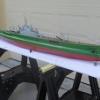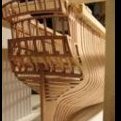-
Posts
6,360 -
Joined
-
Last visited
Reputation Activity
-
 wefalck reacted to michael mott in Bristol Pilot Cutter by michael mott - 1/8 scale - POF
wefalck reacted to michael mott in Bristol Pilot Cutter by michael mott - 1/8 scale - POF
Thanks to all for your complimentary comments and for the additional info on the dorade vents.
When i made the first set of "screws" for attaching the vents to the side of the cabin I used a commercial pin vice that is the traditional one that allows very small diameters down to basically 0 the way it works is a bit hit and miss being a shaft with a couple of cross cuts. This took a few tries each time to get the pin properly centered. I also used a file to reduce the diameter of the pin head and basically did the work by eye. Knowing that when they were assembled in the vents the slight variations in diameter would become obvious. So I decided to make a small pin chuck specifically for these pins. I used a bit of 1/4 inch brass rod and using the collet chuck on the lathe turned down the shaft to fit the new micro drill which is 3/32. Keeping some of the shaft at the 1/4 inch in order to thread the opposite end for the locking collar. This was then reduced and threaded 8x36. The threaded end was then tapered about 1/8 so that the locking nut could work to clamp the threaded end.
The threaded end was drilled with a hole the same diameter as the pin to a depth of 5/32 then slit lengthwise with a .010" slitting blade. The shaft end was drilled to the pin hole with a #50 drill as a relief and to allow the pin end to close.
First picture shows the chuck with the locking nut off. the lock nut was easier to work with the flats filed which allowed a wrench to tighten it instead of my finger and thumb (which got cut on the sharp edges hence the flats)
The cross cut is more visible in the next picture. I cut enough pins to complete both sides. By using the collet chuck and the new pin vice it enables me to complete a single operation on all the pins knowing that they will be concentric for the next operation.
The pins stayed concentric in the new chuck.
The heads were turned down to .93mm which turns out to be just under 5/16 actually closer to 19/64ths in diameter which is very close to the diameter of a #8 round head wood screw at 1:1
The next operation I will shape the round and then slot them using a different pin vice and a block of wood to position the jewelers saw blade as in the next picture.
I will set up the boxes with a slot on the bottom and by bringing the vents up it looks better than having them cross the panel reveal.
That's all for now.
Michael
-
 wefalck reacted to Dziadeczek in La Créole 1827 by archjofo - Scale 1/48 - French corvette
wefalck reacted to Dziadeczek in La Créole 1827 by archjofo - Scale 1/48 - French corvette
You have to explore the possibilities that are offered by people who are into archery. Namely, they use the so called "bow string server" which travels along the served line while serving it at the same time. Please google "bow string server" and select "images" and you'll see many potential solutions.
They typically serve the line for a bow, which is a bit thicker then most of your miniature ropes for shipmodeling, so, if you want to obtain a commercially available gadget, you have to choose a possibly smaller one typically available for archery. Or, make one by yourself from parts which are typically available around your house/workshop. The solutions are endless...
The beauty of such a server is that it requires no, or very little attention, while serving your lines. It hungs suspended from your rope and its weight and tension controlled by the screw (next to a spool with thread), controls how tight is your serving. (Initial setup is therefore required) .
Once you start your serving process, you can literally make yourself a cup of coffee and drink it while observing the action of serving (provided that your serving machine is mechanically powered (electric DC motor) and you are serving a long enough piece of a rope). The server, while serving your rope, WILL AUTOMATICALLY MOVE ALONG THE ROPE without your intervention whatsoever. You can even install a device that will shut off the power to the motor when the serving reaches the end of the rope, so that you don't have to watch the process.
Many years ago I made a simple device for serving - see attachments. It works perfectly for most of my ropes. Bigger (thicker) ropes will require a bigger server, naturally.
-
 wefalck got a reaction from popeye the sailor in Bristol Pilot Cutter by michael mott - 1/8 scale - POF
wefalck got a reaction from popeye the sailor in Bristol Pilot Cutter by michael mott - 1/8 scale - POF
Still one of the Bibels and nice drawings anyway.
-
 wefalck got a reaction from popeye the sailor in Bristol Pilot Cutter by michael mott - 1/8 scale - POF
wefalck got a reaction from popeye the sailor in Bristol Pilot Cutter by michael mott - 1/8 scale - POF
I have seen this arrangement before, but didn’t know that name. I can see very well spray being kept out, albeit at a reduced efficiency of the ventilator due to some air bleeding out of the drainage holes. However, a serious wave would flood the hole system anyway.
-
 wefalck got a reaction from EricWilliamMarshall in La Créole 1827 by archjofo - Scale 1/48 - French corvette
wefalck got a reaction from EricWilliamMarshall in La Créole 1827 by archjofo - Scale 1/48 - French corvette
My machine is still in the planning phase (I actually don't need one at the moment, but it is an interesting project), though I have accumulated most of the materials needed. The base will be 6 mm brown bakelite, which should look nice together with the steel and brass of the mechanism. I may stay manual only, as I won't have to do that long ropes.
I also thought about driving the serving thread spool along with a leadscrew, but then came to the conclusion that one would need a hell of a gear ratio to make this useful, plus change-wheel for different thread thicknesses. Probably not worth the effort.
One point that concerned me was the pull needed to really wind the thread tightly around the rope. This would seriously deflect the rope. So, I will shape a kind of follower or travelling steady in which the rope runs in a channel. In the front a notch will be cut out of the channel in order to be able to feed in the serving thread. It will run over a flat surface so that one can control with the index finger the resistance.
-
 wefalck got a reaction from jackieofalltrades in riveting tool
wefalck got a reaction from jackieofalltrades in riveting tool
I have been able to locate the arcticle I referred to earlier: https://www.proto48.org/p48_art_06.htm
This is the idea for equal spacing from the above article that shows some excellent railway models:
Below is a watchmakers staking tool by Boley. Not mine, which is virtually identical, but more complete, but a picture gleaned from the Internet. They come with a wide variety of punches, pointed, flat, hollow, concave, etc. and anvils.
And this is my watchmakers jewelling press:
It has a micrometer stop, so you can set the exact depth for punching or the thickness for say squashing wires flat. Some staking sets also come with such lever and depth-stop, btw. I make punching inserts and anvils for the job in hand. Don't have pictures yet, but I just made an anvil and die to shape miniature ventilator-handles for my SMS WESPE-project.
-
 wefalck got a reaction from Piet in Bristol Pilot Cutter by michael mott - 1/8 scale - POF
wefalck got a reaction from Piet in Bristol Pilot Cutter by michael mott - 1/8 scale - POF
Still one of the Bibels and nice drawings anyway.
-
 wefalck got a reaction from Chasseur in Bristol Pilot Cutter by michael mott - 1/8 scale - POF
wefalck got a reaction from Chasseur in Bristol Pilot Cutter by michael mott - 1/8 scale - POF
I have seen this arrangement before, but didn’t know that name. I can see very well spray being kept out, albeit at a reduced efficiency of the ventilator due to some air bleeding out of the drainage holes. However, a serious wave would flood the hole system anyway.
-
 wefalck got a reaction from druxey in Bristol Pilot Cutter by michael mott - 1/8 scale - POF
wefalck got a reaction from druxey in Bristol Pilot Cutter by michael mott - 1/8 scale - POF
Still one of the Bibels and nice drawings anyway.
-
 wefalck got a reaction from michael mott in Bristol Pilot Cutter by michael mott - 1/8 scale - POF
wefalck got a reaction from michael mott in Bristol Pilot Cutter by michael mott - 1/8 scale - POF
Still one of the Bibels and nice drawings anyway.
-
 wefalck got a reaction from Piet in Bristol Pilot Cutter by michael mott - 1/8 scale - POF
wefalck got a reaction from Piet in Bristol Pilot Cutter by michael mott - 1/8 scale - POF
I have seen this arrangement before, but didn’t know that name. I can see very well spray being kept out, albeit at a reduced efficiency of the ventilator due to some air bleeding out of the drainage holes. However, a serious wave would flood the hole system anyway.
-
 wefalck got a reaction from BETAQDAVE in La Créole 1827 by archjofo - Scale 1/48 - French corvette
wefalck got a reaction from BETAQDAVE in La Créole 1827 by archjofo - Scale 1/48 - French corvette
My machine is still in the planning phase (I actually don't need one at the moment, but it is an interesting project), though I have accumulated most of the materials needed. The base will be 6 mm brown bakelite, which should look nice together with the steel and brass of the mechanism. I may stay manual only, as I won't have to do that long ropes.
I also thought about driving the serving thread spool along with a leadscrew, but then came to the conclusion that one would need a hell of a gear ratio to make this useful, plus change-wheel for different thread thicknesses. Probably not worth the effort.
One point that concerned me was the pull needed to really wind the thread tightly around the rope. This would seriously deflect the rope. So, I will shape a kind of follower or travelling steady in which the rope runs in a channel. In the front a notch will be cut out of the channel in order to be able to feed in the serving thread. It will run over a flat surface so that one can control with the index finger the resistance.
-
 wefalck got a reaction from popeye the sailor in Arabia 1856 by Cathead - FINISHED - Scale 1:64 - sidewheel riverboat from the Missouri River, USA
wefalck got a reaction from popeye the sailor in Arabia 1856 by Cathead - FINISHED - Scale 1:64 - sidewheel riverboat from the Missouri River, USA
Just an idea for making the dimples more uniform: add a depth-stop in form of an adjustable collar to the ballpoint-pen.
Somewhere on a railway modeling site I saw someone putting a second hole into the anvil at a distance required between two rivets. This acts as a register for making the distances between rivets equal.
Thin copper, brass, or aluminum sheet can be used as well, but then I would make the anvil from brass or steel, with holes drilled of the rivet diameter.
I myself actually purchased a watchmakers ‘staking’ or riveting tool for such work. It comes with various punches and anvils. Another option is a so-called jewelling tool that has an integrated depth-stop and is lever-operated, but one has to make one’s own punches and anvils.
-
 wefalck got a reaction from Canute in riveting tool
wefalck got a reaction from Canute in riveting tool
I have been able to locate the arcticle I referred to earlier: https://www.proto48.org/p48_art_06.htm
This is the idea for equal spacing from the above article that shows some excellent railway models:
Below is a watchmakers staking tool by Boley. Not mine, which is virtually identical, but more complete, but a picture gleaned from the Internet. They come with a wide variety of punches, pointed, flat, hollow, concave, etc. and anvils.
And this is my watchmakers jewelling press:
It has a micrometer stop, so you can set the exact depth for punching or the thickness for say squashing wires flat. Some staking sets also come with such lever and depth-stop, btw. I make punching inserts and anvils for the job in hand. Don't have pictures yet, but I just made an anvil and die to shape miniature ventilator-handles for my SMS WESPE-project.
-
 wefalck got a reaction from Keith Black in SPERWER by KORTES - FINISHED - 1:30 scale - Friescheboeier Yacht
wefalck got a reaction from Keith Black in SPERWER by KORTES - FINISHED - 1:30 scale - Friescheboeier Yacht
Nice work as usual 👍
BTW, the leeboards (zwaards) will also need a hole for attaching the hoisting rope that is belayed on one of the cleats inbord. I gather, the boier also had a hoisting tackle for the leeboards.
-
 wefalck got a reaction from druxey in La Créole 1827 by archjofo - Scale 1/48 - French corvette
wefalck got a reaction from druxey in La Créole 1827 by archjofo - Scale 1/48 - French corvette
My machine is still in the planning phase (I actually don't need one at the moment, but it is an interesting project), though I have accumulated most of the materials needed. The base will be 6 mm brown bakelite, which should look nice together with the steel and brass of the mechanism. I may stay manual only, as I won't have to do that long ropes.
I also thought about driving the serving thread spool along with a leadscrew, but then came to the conclusion that one would need a hell of a gear ratio to make this useful, plus change-wheel for different thread thicknesses. Probably not worth the effort.
One point that concerned me was the pull needed to really wind the thread tightly around the rope. This would seriously deflect the rope. So, I will shape a kind of follower or travelling steady in which the rope runs in a channel. In the front a notch will be cut out of the channel in order to be able to feed in the serving thread. It will run over a flat surface so that one can control with the index finger the resistance.
-
 wefalck got a reaction from Canute in Dremel 8050 micro
wefalck got a reaction from Canute in Dremel 8050 micro
Don't know what collets the Dremel uses, but the PROXXON collets are very good and durable. This would be one of my key criteria - for a hand-held tool you don't want to mess around with drill-chuck that obstructs your view etc. The collets accomodate up to 3.2 mm, which is 1/8", so one can use both metric and imperial inserts and drills.
-
 wefalck got a reaction from Jim Rogers in riveting tool
wefalck got a reaction from Jim Rogers in riveting tool
I have been able to locate the arcticle I referred to earlier: https://www.proto48.org/p48_art_06.htm
This is the idea for equal spacing from the above article that shows some excellent railway models:
Below is a watchmakers staking tool by Boley. Not mine, which is virtually identical, but more complete, but a picture gleaned from the Internet. They come with a wide variety of punches, pointed, flat, hollow, concave, etc. and anvils.
And this is my watchmakers jewelling press:
It has a micrometer stop, so you can set the exact depth for punching or the thickness for say squashing wires flat. Some staking sets also come with such lever and depth-stop, btw. I make punching inserts and anvils for the job in hand. Don't have pictures yet, but I just made an anvil and die to shape miniature ventilator-handles for my SMS WESPE-project.
-
 wefalck got a reaction from Canute in Generic Photoetch
wefalck got a reaction from Canute in Generic Photoetch
What kind of dimensions/scale are you looking for ?
-
 wefalck got a reaction from Jeronimo in La Créole 1827 by archjofo - Scale 1/48 - French corvette
wefalck got a reaction from Jeronimo in La Créole 1827 by archjofo - Scale 1/48 - French corvette
My machine is still in the planning phase (I actually don't need one at the moment, but it is an interesting project), though I have accumulated most of the materials needed. The base will be 6 mm brown bakelite, which should look nice together with the steel and brass of the mechanism. I may stay manual only, as I won't have to do that long ropes.
I also thought about driving the serving thread spool along with a leadscrew, but then came to the conclusion that one would need a hell of a gear ratio to make this useful, plus change-wheel for different thread thicknesses. Probably not worth the effort.
One point that concerned me was the pull needed to really wind the thread tightly around the rope. This would seriously deflect the rope. So, I will shape a kind of follower or travelling steady in which the rope runs in a channel. In the front a notch will be cut out of the channel in order to be able to feed in the serving thread. It will run over a flat surface so that one can control with the index finger the resistance.
-
 wefalck got a reaction from mtaylor in Bristol Pilot Cutter by michael mott - 1/8 scale - POF
wefalck got a reaction from mtaylor in Bristol Pilot Cutter by michael mott - 1/8 scale - POF
Still one of the Bibels and nice drawings anyway.
-
 wefalck got a reaction from druxey in Bristol Pilot Cutter by michael mott - 1/8 scale - POF
wefalck got a reaction from druxey in Bristol Pilot Cutter by michael mott - 1/8 scale - POF
I have seen this arrangement before, but didn’t know that name. I can see very well spray being kept out, albeit at a reduced efficiency of the ventilator due to some air bleeding out of the drainage holes. However, a serious wave would flood the hole system anyway.
-
 wefalck reacted to michael mott in riveting tool
wefalck reacted to michael mott in riveting tool
Here is a simple riveting tool I made to punch small rivet impressions in metal or styrene.
the punches are made from 1/4 inch drill rod with brass anvils
quite complex layouts ate possible by using a marked layout or very straight sets using the fence
One of the ways in which the spacing of the rivets is accomplished is by setting the anvil up in such a way that there is a set distance from the recess in the anvil and the edge the punched rivet then is registered against the edge before the next rivet is punched. The Anvils are made of brass and the depression is done with a hardened punch made from the 1/4 inch drill rod. These are all nominal dimensions of course because any combination of nominal sizes will suffice.
A fine ball point pen works well also in soft brass or copper.
The hardwood dowel would only be useful for a short few rivets a harder anvil of brass or steel would be much better.
Wefalk mentioned in Eric's Arabia thread "Somewhere on a railway modeling site I saw someone putting a second hole into the anvil at a distance required between two rivets. This acts as a register for making the distances between rivets equal.
Thin copper, brass, or aluminum sheet can be used as well, but then I would make the anvil from brass or steel, with holes drilled of the rivet diameter."
Perhaps there are some other great Ideas regarding this subject that would be helpful.
Michael
-
 wefalck reacted to archjofo in La Créole 1827 by archjofo - Scale 1/48 - French corvette
wefalck reacted to archjofo in La Créole 1827 by archjofo - Scale 1/48 - French corvette
First of all, many thanks for the greetings for the New Year and I hope that your interest in my report will continue in the New Year as well.
Steve, thank you very much for your nice comment.
Before I start with the shrouds, I still need a device for serving ropes.
First of all, I drew a plan to get the material and parts.
The first attempts with the rope serving machine were very successful.
In order to be able to control the tension on the thread better, I have to think of a supplement for the device.
-
 wefalck got a reaction from mtaylor in SPERWER by KORTES - FINISHED - 1:30 scale - Friescheboeier Yacht
wefalck got a reaction from mtaylor in SPERWER by KORTES - FINISHED - 1:30 scale - Friescheboeier Yacht
Nice work as usual 👍
BTW, the leeboards (zwaards) will also need a hole for attaching the hoisting rope that is belayed on one of the cleats inbord. I gather, the boier also had a hoisting tackle for the leeboards.




.thumb.jpeg.fc5d633a7b34428fcf19419a73d56d55.jpeg)








